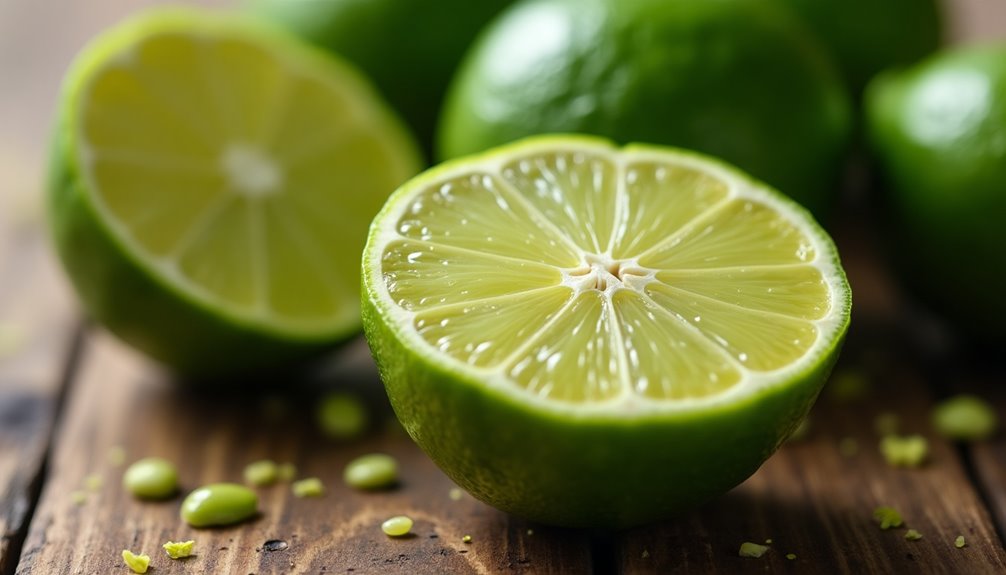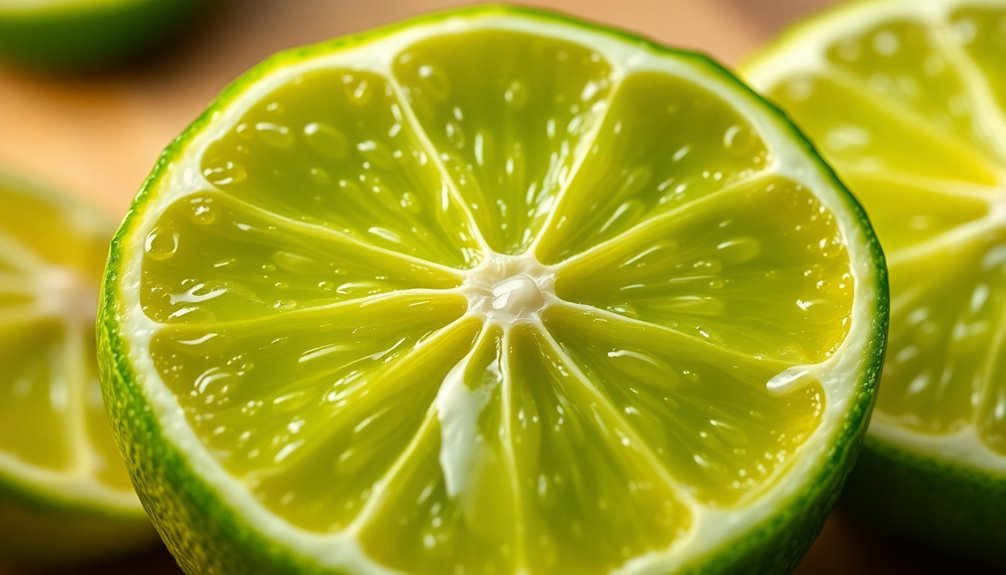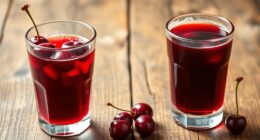A medium lime typically yields about 2 tablespoons of juice, or roughly 1 ounce. Of course, this can vary depending on the lime's size and ripeness. To make the most of your lime, try rolling it on a cutting board before cutting, as this helps release more juice. Knowing how much juice you can get from one lime is essential for recipe success. There's even more to discover about maximizing lime juice extraction and culinary uses!
Key Takeaways
- One medium lime typically yields about 2 tablespoons of juice or approximately 1 ounce.
- Juice yield can vary depending on the lime's size and ripeness.
- Rolling the lime before cutting can enhance juice extraction significantly.
- For recipes requiring 1/4 cup of lime juice, about 2 limes are needed.
- Selecting heavy limes generally indicates a higher juice content inside.

Have you ever wondered how much juice you can squeeze from a single lime? If you're diving into a new recipe or mixing up a refreshing cocktail, knowing the yield of one lime can really help you gauge your ingredients. Typically, one medium lime yields about 2 tablespoons of fresh lime juice, which is roughly 1 ounce. This amount may vary slightly based on the lime's size and ripeness, but you can generally count on it to provide enough juice for most culinary needs.
When you're in the kitchen, it's essential to maximize the juice you extract from your limes. A simple yet effective tip is to roll the lime on a cutting board before cutting it open. This technique breaks down the internal membranes and helps release more juice, ensuring you're getting the most out of that single lime. Once you've rolled it around, slice it in half and squeeze away. You'd be surprised at how much juice can come from just one lime when you employ this method!
If your recipe calls for a specific amount of lime juice, it's helpful to know how many limes you'll need. For instance, if you need 1/4 cup of lime juice for a zesty dressing or marinade, you're looking at approximately 2 limes. With each lime yielding about 2 tablespoons of juice, you can easily measure out what you need without any guesswork. This precision can save you from running short on ingredients mid-preparation.
In various recipes, lime juice can elevate the flavor profile, adding a bright and tangy kick that enhances everything from salads to desserts. Whether you're making a classic guacamole, a refreshing mojito, or a zesty vinaigrette, understanding how much juice you can get from one lime can streamline your cooking process. You won't have to worry about over or underestimating your lime juice requirements, which can be especially helpful when you're hosting a dinner party or preparing for a special occasion.
When selecting limes, keep an eye out for those that feel heavy for their size. These usually have more juice inside, ensuring that you get maximum yield.
And if you find yourself with an excess of limes, don’t hesitate to juice them all! You can store fresh lime juice in the refrigerator for a few days or freeze it in ice cube trays for later use. This way, you’ll always have fresh lime juice on hand for your culinary endeavors. In addition to juicing them, you can also zest the limes before juicing and store the zest for added flavor in other dishes. For those looking for fresh lime juice storage tips, consider labeling your ice cube trays with the date to keep track of freshness. This method not only prevents waste but also ensures you can enjoy the bright taste of lime whenever you need it.
Next time you reach for a lime, remember these tips to make the most of your juice. Whether you need a little or a lot, one lime can often meet your culinary needs, making it a versatile ingredient you'll love keeping in your kitchen. So, roll that lime and get ready to squeeze!
Frequently Asked Questions
How Much Juice Is in 1 Lime?
When you're juicing a lime, you can expect it to yield about 2 tablespoons, or roughly 1 ounce of juice.
This amount can vary slightly based on the lime's size and ripeness, but typically, you'll find that a medium lime gives you a consistent result.
If you need more juice, just grab a couple more limes to reach your desired quantity.
Fresh lime juice really enhances your dishes with its vibrant flavor!
Can I Substitute Bottled Lime Juice for Fresh Lime Juice?
You can substitute bottled lime juice for fresh lime juice, but you mightn't get the same vibrant flavor.
Bottled juice often tastes flat due to preservatives, so you'll need about 1.5 times the amount to mimic fresh juice's brightness.
If you're in a pinch, organic bottled lime juice is a better choice, but always remember that fresh lime juice enhances dishes, especially cocktails and marinades, with its unique acidity and aroma.
How Much Real Lime Equals 1 Lime?
To figure out how much real lime equals one lime, you should know that one medium lime typically gives you about 2 tablespoons of juice.
If you need a specific amount, like 1/4 cup, you'd use about 2 limes.
Keep in mind that the size and ripeness of the lime can affect the yield, but generally, you can count on that 2-tablespoon estimate for a standard lime.
How Much Juice Is in One Key Lime?
When you're juicing a key lime, you can expect to get about 1 tablespoon of juice on average.
Since key limes are smaller and rounder, they yield less juice than regular limes.
If you're making a recipe that calls for a specific amount, keep in mind that you might need around 20 key limes to reach 1/2 cup of juice.
Conclusion
So, next time you're in the kitchen, thinking about that zesty lime, remember—you're likely to squeeze out about 2 tablespoons of juice from just one. But what if you need more? What if one lime isn't enough for your recipe? As you ponder that, consider the secret techniques you could use to maximize every drop. The culinary possibilities await, and you're just a squeeze away from transforming your dish. What will you create next?
Cindy thoroughly researches juicing trends, techniques, and recipes to provide readers with practical advice and inspiration. Her writing style is accessible, engaging, and designed to make complex concepts easy to understand. Cindy’s dedication to promoting the advantages of juicing shines through her work, empowering readers to make positive changes in their lives through the simple act of juicing.











